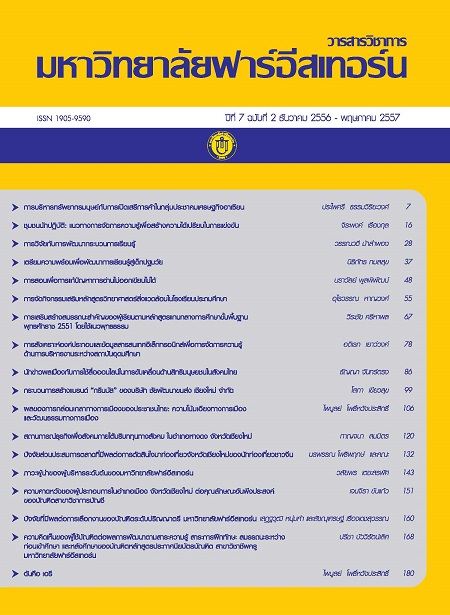ผลของการกล่อมเกลาทางการเมืองของประชาชนไทย : ความโน้มเอียงทางการเมืองและวัฒนธรรมทางการเมือง
Main Article Content
Abstract
การวิจัยนี้ มีวัตถุประสงค์เพื่อศึกษาความโน้มเอียงทางการเมืองและวัฒนธรรมทางการเมืองของประชาชนไทย ผลการศึกษาพบว่า ประชาชนไทยโดยส่วนใหญ่ (1,253 คน คิดเป็นร้อยละ 62.7) มีคะแนนรวมความโน้มเอียงทาง การเมืองทั้งสามประการอย่างถูกต้องและเหมาะสมในระดับปานกลาง แต่เมื่อพิจารณาที่ค่าเฉลี่ยของกลุ่มตัวอย่าง ทั้งหมดก็สามารถจำแนกได้เป็นมีความโน้มเอียงทางการเมืองด้านความรู้เพียงเล็กน้อย (1.1385 คะแนน จากคะแนน เต็ม 4.0000) แต่กลับมีระดับความรู้สึกผูกพันและการประเมินคุณค่าที่มากกว่า (2.5415 และ 2.2620 ตามลำดับ) นอกจากนี้ ยังพบว่า ค่าเฉลี่ยคะแนนรวมความโน้มเอียงทางการเมืองของประชาชนไทยในพื้นที่เทศบาลและ พื้นที่ อบต. ไม่แตกต่างกันอย่างมีนัยสำคัญทางสถิติที่ระดับ .05 ในทางตรงกันข้าม ค่าเฉลี่ยคะแนนรวมความโน้มเอียง ทางการเมืองของประชาชนไทยในแต่ละภูมิภาค พบว่า มีคู่ภูมิภาคที่มีความแตกต่างกันอย่างมีนัยสำคัญทางสถิติ ที่ระดับ .05 จำนวน 7 คู่ ได้แก่ 1) ภาคเหนือและภาคตะวันออกเฉียงเหนือ 2) ภาคเหนือและภาคกลาง 3) ภาคเหนือ และภาคใต้ 4) ภาคเหนือและ กทม. 5) ภาคตะวันออกเฉียงเหนือและภาคกลาง 6) ภาคกลางและภาคใต้ และ 7) ภาคกลางและ กทม. และในประการสุดท้ายได้ค้นพบว่า ประชาชนไทยโดยส่วนใหญ่ (ร้อยละ 71.9 - 81.2) มีวัฒนธรรมทางการเมืองแบบมีส่วนร่วม
The objectives of this research were to study political orientations and political cultures of the Thais. The findings of this study were as followed. Most of the Thais (1,253 people or 62.7 percent) had the sum score of three types of political orientation in the correct or appropriate way on the middle level. As specify on the average scores of the total sample, they could be divided into having the cognitive orientation on a low score (1.1385 from 4.0000) but having more scores on the affective orientation and the evaluative orientation (2.5415 and 2.2620 in order). Moreover, the average scores of the political orientation of the Thais between living in the municipal area and living in the Tambon administrative organization area were not statistical significantly different on the level of .05. On the other hand, for the average scores of the political orientation of the Thais compared with living in each of the regions, there were the seven couples of region that had the statistical significant difference on the level of .05. They were the regions between 1) the north and the north-eastern, 2) the north and the middle, 3) the north and the south, 4) the north and Bangkok, 5) the north-eastern and the middle, 6) the middle and the south, and 7) the middle and Bangkok. Finally, most of the Thais (71.9 - 81.2 percent) had the participant political culture.
Article Details
1. Any views and comments in the FEU Academic Review Journal are the authors’ views. The editorial staff have not to agree with those views and it is not considered as the editorial’s responsibility.
2. The responsibility of content and draft check of each article belongs to each author. In case, there is any lawsuit about copyright infringement. It is considered as the authors’ sole responsibility.
3. The article copyright belonging to the authors and the Far Eastern University are copyrighted legally. Republication must be received direct permission from the authors and the Far Eastern University in written form.
